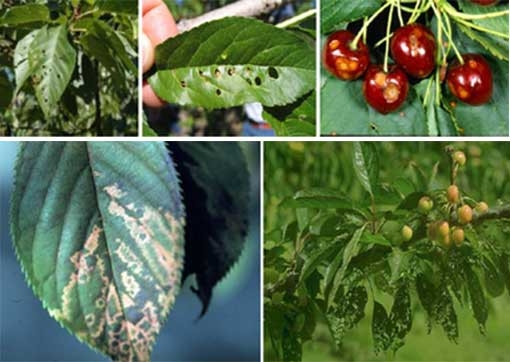Just when your cherry patch was looking magnificent, you turn your back and suddenly those healthy green leaves are not looking so good—they are full of holes, or looking a bit tattered.
Shot hole, latent infections of bacterial gummosis and necrotic ringspot virus are three diseases that come to mind.
Shot hole (Coryneum blight)
Disease symptoms
First symptoms of infection appear as small red spots on young leaves. The spots enlarge and become purple with a tan-white centre.
The spots then drop out of the leaf blade to leave a ‘shot hole’.
Severe leaf infections produce numerous holes and give the affected leaves a very tattered appearance.
Fruit infections begin as purple-red spots on the fruit skin as early as shuck-split and may occur as late as at harvest.
Survival and spread
The fungus typically overwinters on infected dormant buds and in small twig cankers.
Favourable conditions
Warmer temperatures and wet weather splashes and wind-blown rain favours the development of disease.
Bacterial gummosis (Pseudomonas syringae)
Disease symptoms
Symptoms appear as cankers that exude amber-coloured gum. These may be found on twigs, at the base of flower and leaf buds, in pruning wounds, or at the base of spurs.
Cankers spread upwards and form sunken areas in winter.
If the pathogen enters dormant buds the buds may be killed or they may open normally in spring before collapsing in early summer. Infected buds may be symptomless.
Survival and spread
Pseudomonas syringae survives on plant surfaces, is spread by splashing rain, and is favoured by high moisture and low temperatures in spring.
The disease is worse in low or sandy spots in the orchard. Vigorous trees are less susceptible to bacterial canker, while young trees, two to eight years old, are most affected.
The disease rarely occurs in the first year of planting and should not be common in nurseries.
Favourable conditions
High humidity and warm temperatures favour the development of disease.
Prunus necrotic ringspot virus (PNRSV)
Disease symptoms
Shock symptoms, followed by chronic symptoms, are produced in trees not already infected.
The occurrence of shock symptoms depends on climatic conditions. The number of virus strains and the difference in tolerance of host species results in unlimited variations in symptoms.
Symptoms generally consist of chlorosis, necrosis, leaf deformity and stunting.
Entire plants may be affected, or only a portion may show symptoms.
Normal PNRSV symptoms consist of a few rings or chlorotic areas that may develop into severe necrotic spotting and a shot hole appearance.
Careful inspection of sweet cherry trees in late spring may reveal scattered older leaves or entire spurs with necrotic spotting or etched rings.
Sometimes one branch will show tattered leaves or symptoms of the rugose mosaic strain.
Yield on trees infected with the normal strain is reduced about 5%.
Survival and spread
The virus spreads through transmission by vectors. Weed hosts serve as natural virus reservoirs.
Favourable conditions
A long and continuous dry spell increases the disease incidence.
Disease management
Identification of the problem—be it disease or virus—should be the first move.
Some hints about steps to improve the situation will be found in next month’s column.
See this article in Tree Fruit Nov 2019




















